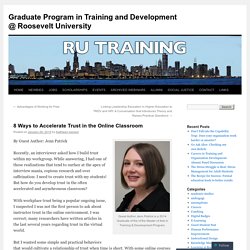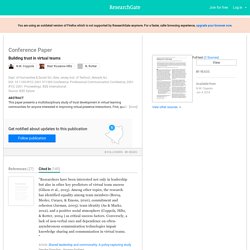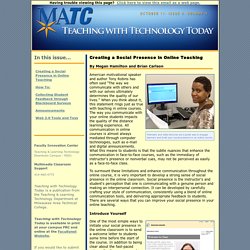

Graduate Program in Training and Development @ Roosevelt University. Guest Author Jenn Patrick is a 2014 Graduate of the of the Master of Arts in Training & Development Program.

By Guest Author: Jenn Patrick Recently, an interviewer asked how I build trust within my workgroup. While answering, I had one of those realizations that tend to surface at the apex of interview mania, copious research and over caffeination: I need to create trust with my students! But how do you develop trust in the often accelerated and asynchronous classroom? With workplace trust being a popular ongoing issue, I suspected I was not the first person to ask about instructor trust in the online environment.
But I wanted some simple and practical behaviors that would cultivate a relationship of trust when time is short. Swift Trust in Online Learning Below are some suggested strategies any instructor can use to quickly build trust in the online classroom. Keep Your Commitments – Do what you say you are going to do and within the time frame that you specify. References. Building trust in virtual teams. You are using an outdated version of Firefox which is not supported by ResearchGate anymore.

For a faster, safer browsing experience, upgrade your browser now. <div class="c-box-warning full-width-element" style="text-align: center; "><div style="margin: auto; padding:10px;" class="container"><b>For full functionality of ResearchGate it is necessary to enable JavaScript. Here are the <a href=" rel="nofollow" target="_blank"> instructions how to enable JavaScript in your web browser</a>. </b></div></div> Conference Paper Building trust in virtual teams Dept. of Humanities & Social Sci., New Jersey Inst. of Technol., Newark, NJ DOI: 10.1109/IPCC.2001.971585 Conference: Professional Communication Conference, 2001. Source: IEEE Xplore. Constructivism Through Social Presence and Swift Trust: Facilitat.
Creating Trust in Online Education. In order to have a productive learning environment, the instructor needs to develop and maintain a sense of trust between and among the students and the instructor through good course design and facilitation, says Nancy Coppola, associate professor of humanities at New Jersey Institute of Technology.

In a study that looked at developing trust in virtual teams, Coppola and her colleagues built on the work of Meyerson, et al. that looked at “swift trust,” “a unique form of collective perception … for temporary, but not trivial, situations.” For the purpose of the study Coppola and her colleagues used these previous researchers’ definition of swift trust, which frames trust in temporary situations in terms of the following characteristics: To determine the effects of trust in online learning, Coppola and her colleagues identified the most effective teacher from among those they had studied based on 1,300 post-course questionnaires that rated instructor effectiveness. Reference. Cultural diversity emotional reflex. EJ1092162. Empathy and online interpersonal trust. Generic Template Structure. Over the years, a number of institutions have identified features to be included in every online course.

The following model originated at Utah State University. Start Here Start Here may be a link from the home page of the blended course or announcement. It serves to provide students with initial information to get started in the online portion of your course. The content you might include in this section is: Instructor or Course Introduction The introduction may be delivered in a text, audio, or video format.
Technical Resources How do students get help? Help deskTechnical tutorialsWritten instructions Syllabus Provide your course syllabus and schedule. Put your class schedule on a separate page, include all assignments and due dates, and make it printer-friendly. Course Content Use whatever name fits this section of your course. Organization is a key success factor for students. BlendKit Course References Coppola, N. Onlineclass. 250760121a. MATC-Teaching with Technology Today: October 2011, Issue 4, Volume 4. Creating a Social Presence in Online Teaching By Megan Hamilton and Brian Carlson American motivational speaker and author Tony Robins has often said "The way we communicate with others and with our selves ultimately determines the quality of our lives.

" When you think about it, this statement rings just as true with teaching in online courses. The way you communicate with your online students impacts the quality of the distance learning experience. All communication in online courses is almost always mediated through computer technologies, such as e-mail and digital announcements. To surmount these limitations and enhance communication throughout the online course, it is very important to develop a strong sense of social presence in the online classroom. Introduce Yourself One of the most simple ways to initiate your social presence in the online classroom is to send a welcome letter to students some time before the start of the course. Regularly Use Blackboard's E-mail Tool. Sloan - C: Five Pillars of Online Education. UNLV's Office of Online Education.